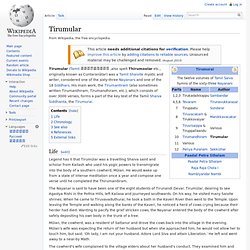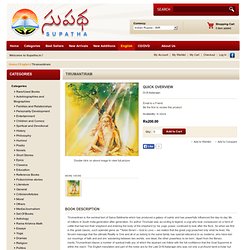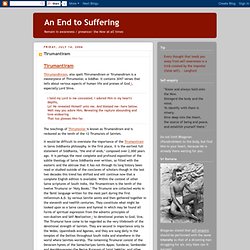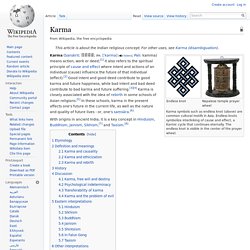

KINGDOM OF SITHTHARS. Those who follow yogic way and those who are in search of spiritual knowledge will definitely know about Thirumanthiram.

Thirumanthiram was written by Thirumoolar. There are many folk stories about Thirumoolar. It's natural that we will doubt those stories. So we can better leave that research. But it's true that there lived a Siththar named Thirumoolar. The Yogis of TIbet. Tibetan Book of The Dead - The Great Liberation - NFB. Tibetian Yoga Masters 2/3. Tibetian Yoga Masters 3/3. Yogis Of Tibet (2002)- Full Movie. Tibetan Buddhism: Secrets of the Yogis of Tibet - Part 1. Tibetian Yoga Masters 1/3.
BBC.The Lost World Of Tibet.El Mundo Perdido de Tíbet.SubEsp.avi. Spiritual: 2012, Future of Mankind, Mayan Calendar Dooms Day. Milarepa: Appearance of Deities. Supernatural revealed in india. Flying Girl-Russia-Original & TV News (Old videos).flv. Magician Ramana Impossible Balance (Indian Magic) in Leidseplein, Amsterdam. Buddhist Monk Levitation - Full Movie. Zen Buddhism - The Land of the Disappearing Buddha - Japan (BBC 1977).avi. Tirumular. Tirumular (Tamil:திருமூலர் ,also spelt Thirumoolar etc., originally known as Cuntaranātar) was a Tamil Shaivite mystic and writer, considered one of the sixty-three Nayanars and one of the 18 Siddhars.

His main work, the Tirumantiram (also sometimes written Tirumanthiram, Tirumandhiram, etc.), which consists of over 3000 verses, forms a part of the key text of the Tamil Shaiva Siddhanta, the Tirumurai. Life[edit] Legend has it that Tirumūlar was a travelling Shaiva saint and scholar from Kailash who used his yogic powers to transmigrate into the body of a southern cowherd, Mūlan. He would wake up from a state of intense meditation once a year and compose one verse until he completed the Thirumandiram. The Nayanar is said to have been one of the eight students of Tirunandi Devar. Mūlan, the cowherd, was a resident of Sattanur and drove the cows back into the village in the evening. The cowherd's wife complained to the village elders about her husband’s conduct. Chronology[edit] Tirumantiram. Table Of Contents. Secret of levitation in india. Tirumantiram. Thirumandhiram, is a Tamil Hindu poetic work written in the tenth century BCE by Thirumoolar.

Tantra Three Tirumantiram. Tirumantiram. Tirumantiram - English. Tirumantiram is the seminal text of Saiva-Siddhanta which has produced a galaxy of saints and has powerfully influenced the day-to-day life of millions in South India,generation after generation.

It’s author Tirumular was according to legend, a yogi who took compassion on a herd of cattle that had lost their shepherd and entering the body of the shepherd by his yogic power, continued to look after the flock. So when we find in this great classic, such splendid gems as ""Anbe Sivam’-- God is Love -- we realize that the great yogi preached only what he lived. His fervent message that the ultimate Reality is One and all of us belong to the same family has special relevance to us moderns, who have lost our moorings of faith and and are ‘wandering between two worlds, one dead, the other powerless to be born.’
Tirumantiram. Tirumantiram Thirumandhiram, also spelt Thirumandiram or Tirumandiram is a masterpiece of Thirumoolar, a Siddhar.

It contains 3047 verses that tells about various aspects of human life and praises of God i, especially Lord Shiva. I held my Lord in me concealed, I adored Him in my heart's depths, Lo! He revealed Himself unto me, And blessed me--here below, Well may you adore Him, Revealing the rapture abounding and love endearing That too pleases Him far. Secrets of Tirumantiram, an ancient Tamil classic-1 Tirumoolar’s Kundalini Techniques:
What is Kundalini?

Kundalini or Serpent Power or Chakra Power is a natural power that lies in each and every human being. Then what is so special about it? This energy is responsible for our consciousness to rise to higher levels. This is responsible for the evolution of man. From Homo erectus to Homo sapiens, that is from monkey to man, this energy was responsible for our consciousness to bloom. So, what is consciousness? A rock does its duty. Then came so called ‘life’, a next step in the evolution of a rock. Vedic Origins Of Civilization & The Fallacy Of The "Aryan Invasion" Myth. Pranayama, திருமூலர் அருளிய பிராணாயாமம் Tirumular - Parasuraman.mp4. Thirumanthiram speech_3_okkanindraanai.wmv.
Jesus en la India 1 de 3. BBC Documentary. The lost tomb of Jesus" BANNED in India. Jesus in India - Beyond Belief Documentary. Govt of India Documentry on Jesus in Kashmir !! Where was Jesus for 18 years? Missing in Bible Part 1/2. LOST TRIBE OF ISRAEL IN INDIA RETURNS TO ISRAEL. Dogma. Dogma is a principle or set of principles laid down by an authority as incontrovertibly true.[1] It serves as part of the primary basis of an ideology or belief system, and it cannot be changed or discarded without affecting the very system's paradigm, or the ideology itself.

The term can refer to acceptable opinions of philosophers or philosophical schools, public decrees, religion, or issued decisions of political authorities.[2] The term derives from Greek δόγμα "that which seems to one, opinion or belief"[3] and that from δοκέω (dokeo), "to think, to suppose, to imagine".[4] Dogma came to signify laws or ordinances adjudged and imposed upon others by the First Century. Karma. Endless knot Nepalese temple prayer wheel Karma symbols such as endless knot (above) are common cultural motifs in Asia.

Endless knots symbolize interlinking of cause and effect, a Karmic cycle that continues eternally. The endless knot is visible in the center of the prayer wheel. Dharma. Dharma ([dʱəɾmə]; Sanskrit: धर्म dharma, listen ; Pali: धम्म dhamma) is a key concept with multiple meanings in the Indian religions Hinduism, Buddhism, Sikhism and Jainism.[8] There is no single word translation for dharma in western languages.[9] The Classical Sanskrit noun dharma is a derivation from the root dhṛ, which has a meaning of "to hold, maintain, keep".

[note 3] The word "dharma" was already in use in the historical Vedic religion, and its meaning and conceptual scope has evolved over several millennia.[12] The antonym of dharma is adharma. Etymology[edit]